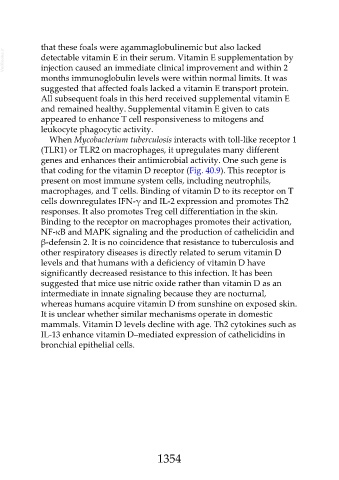Page 1354 - Veterinary Immunology, 10th Edition
P. 1354
that these foals were agammaglobulinemic but also lacked
VetBooks.ir detectable vitamin E in their serum. Vitamin E supplementation by
injection caused an immediate clinical improvement and within 2
months immunoglobulin levels were within normal limits. It was
suggested that affected foals lacked a vitamin E transport protein.
All subsequent foals in this herd received supplemental vitamin E
and remained healthy. Supplemental vitamin E given to cats
appeared to enhance T cell responsiveness to mitogens and
leukocyte phagocytic activity.
When Mycobacterium tuberculosis interacts with toll-like receptor 1
(TLR1) or TLR2 on macrophages, it upregulates many different
genes and enhances their antimicrobial activity. One such gene is
that coding for the vitamin D receptor (Fig. 40.9). This receptor is
present on most immune system cells, including neutrophils,
macrophages, and T cells. Binding of vitamin D to its receptor on T
cells downregulates IFN-γ and IL-2 expression and promotes Th2
responses. It also promotes Treg cell differentiation in the skin.
Binding to the receptor on macrophages promotes their activation,
NF-κB and MAPK signaling and the production of cathelicidin and
β-defensin 2. It is no coincidence that resistance to tuberculosis and
other respiratory diseases is directly related to serum vitamin D
levels and that humans with a deficiency of vitamin D have
significantly decreased resistance to this infection. It has been
suggested that mice use nitric oxide rather than vitamin D as an
intermediate in innate signaling because they are nocturnal,
whereas humans acquire vitamin D from sunshine on exposed skin.
It is unclear whether similar mechanisms operate in domestic
mammals. Vitamin D levels decline with age. Th2 cytokines such as
IL-13 enhance vitamin D–mediated expression of cathelicidins in
bronchial epithelial cells.
1354

